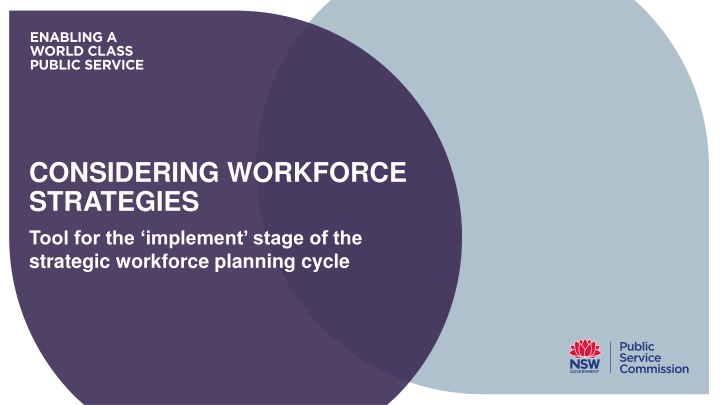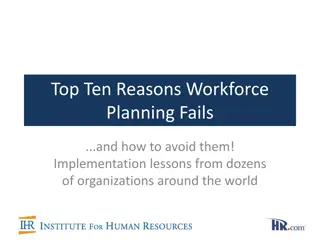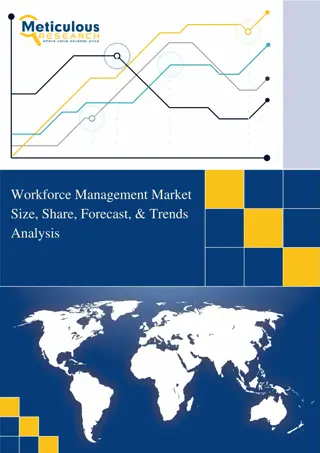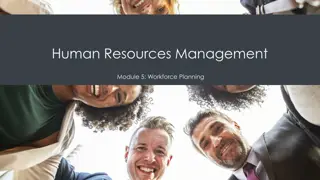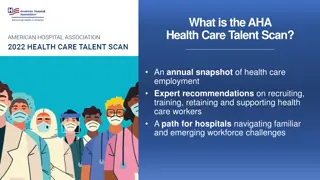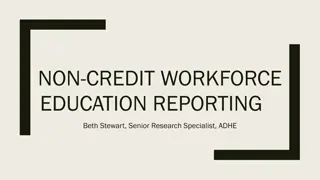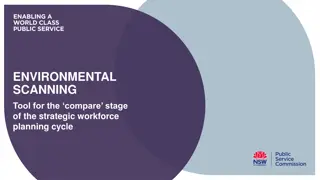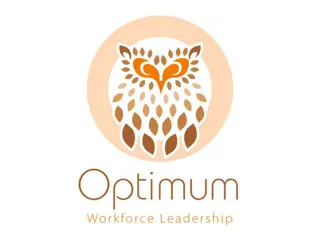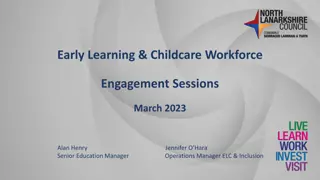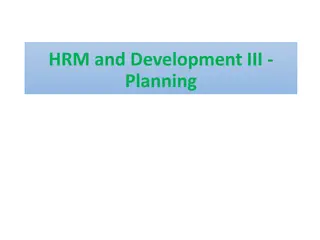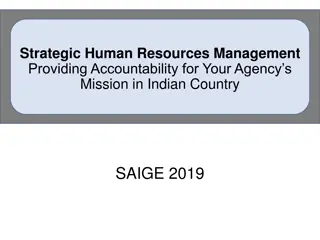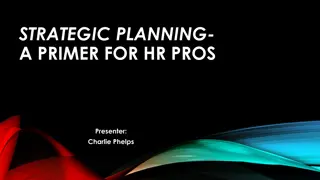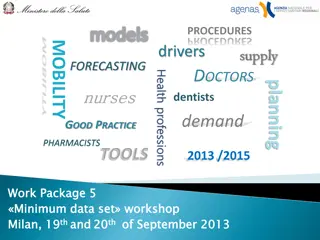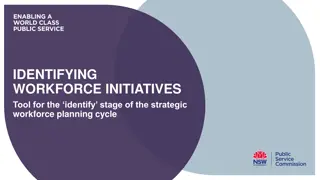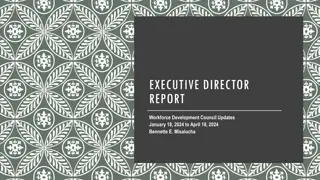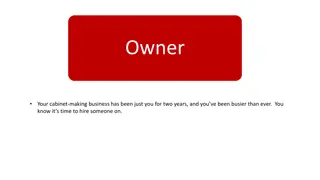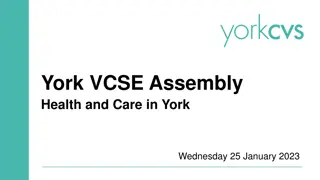Implementing Workforce Strategies for Strategic Planning
In the Implement stage of strategic workforce planning, it is crucial to consider various workforce strategies for meeting organizational goals effectively. This involves analyzing workforce options, building plans, and utilizing the 6 B's model - Build, Buy, Borrow, Bind, Bounce, and Boost. Tailoring these strategies to your organization's needs can lead to impactful outcomes and improved workforce management.
Download Presentation

Please find below an Image/Link to download the presentation.
The content on the website is provided AS IS for your information and personal use only. It may not be sold, licensed, or shared on other websites without obtaining consent from the author.If you encounter any issues during the download, it is possible that the publisher has removed the file from their server.
You are allowed to download the files provided on this website for personal or commercial use, subject to the condition that they are used lawfully. All files are the property of their respective owners.
The content on the website is provided AS IS for your information and personal use only. It may not be sold, licensed, or shared on other websites without obtaining consent from the author.
E N D
Presentation Transcript
CONSIDERING WORKFORCE STRATEGIES Tool for the implement stage of the strategic workforce planning cycle
Please note: This tool has been developed to assist you with: 1) Considering workforce options 2) Building your plan This is not a comprehensive tool for the Implement stage of the Strategic Workforce Planning cycle. These templates will assist you with certain aspects of the Implement stage. To learn about all the aspects of the Implement stage, register for the NSW Government Strategic Workforce Planning Masterclasses Goal of the Implement stage Identify actions to meet work and workforce requirements to achieve organisational goals and manage any associated risks. Please note that you may not need to use all elements of this tool. You may tailor or modify the templates based on the needs and strategic workforce planning maturity of your organisation. Additional information If you need further information or would like to provide feedback, please contact the NSW Public Service Commission at swp@psc.nsw.gov.au 2
Considering workforce options the 6 B's In the Implement stage of the Strategic Workforce Planning cycle, we look at the diverse range of workforce strategies available to build the workforce we'll need in the future. The 6 B s model refers to the range of workforce strategies available: Build, Buy, Borrow, Bind, Bounce, and Boost. This tool gives a brief overview of each workforce strategy and provides you with a series of questions based on the 6 B s to help you choose workforce strategies that have a positive impact and helps your organisation achieve its strategic objectives. Tips on how to use this tool Be objective and aware of any biases or assumptions you might have when asking yourself these questions This can be used as a discussion framework with your team and stakeholders, so you can agree on the right actions to take Note that the ease of implementation is about your capacity and capability something that s high impact might be hard to implement, but worth the investment because of the potential value and outcomes it will achieve 3
Options for workforce supply the 6 B's BIND BUY Retain critical talent and capability Success and reward levers Actively reducing turnover Redeployment Recruit internally or externally Talent pools, secondments Workforce as referrers Employee value proposition BUILD BOUNCE Capability uplift Remove under performers Redundancy Early retirements Learning and development Cross skill, upskill and reskill Promotion Job shadowing and job swaps BOOST BORROW Transformation to lift efficiency and productivity Process review and change Digitisation and technology Robotics Outsource, co-source and in- source Project-based teams Consultants Joint ventures 4
1) Considering Workforce Options Decision Framework When faced with the choice of which workforce supply option to invest time and energy in, the questions below offer a framework to assist you with the decision-making process. By identifying the Potential Impact and Ease of Implementation, you can assess which options are appropriate for the issue you re addressing. The ideal option will be high impact and easy to implement. Context Define the problem to be solved/issue to addressed: Approach: Buy - Recruiting, attracting, resourcing Question Comments or Response Potential Impact (High/ Medium/ Low) Ease of Implementation (Easy/ Hard) What resource pools are available and affordable in the timeframes we need? What is necessary for us to attract the right capabilities (skills, knowledge and experience) we need? Do we need to shake up the organisation to bring in new ideas and perspectives, break old cultural roadblocks and uplift capability? Approach: Build - Development and capability uplift Question Comments or Response Potential Impact (High/ Medium/ Low) Ease of Implementation (Easy/ Hard) What time and budget constraints do we face with the build option? Can we effectively identify high performers and critical attributes and use them to model behaviour? Do we have a culture of flexibility and lifelong learning that will address future capability needs? 5
1) Considering Workforce Options Decision Framework (continued) Approach: Borrow - Partnering and skill share Question Comments or Response Potential Impact (High/ Medium/ Low) Ease of Implementation (Easy/ Hard) Are there short-term opportunities across organisations or business units to mitigate gaps? Do we need to bring in new ideas, frameworks and tools and are they able to be adapted to our context? Will we be able to transfer the knowledge in-house or will it result in paying repeatedly for the same capability? Approach: Bind - Retention Rewards and recognition Question Comments or Response Potential Impact (High/ Medium/ Low) Ease of Implementation (Easy/ Hard) How confident are we that we know what will retain our critical talent? Where are we at risk of losing key capabilities and why? Are our retention strategies targeted and effective in retaining our critical and accelerator roles? E.g., cross-functional projects, rewards and recognition, leadership development 6
1) Considering Workforce Options Decision Framework (continued) Approach: Bounce - Remove underperformers and redundancy Question Comments or Response Potential Impact (High/ Medium/ Low) Ease of Implementation (Easy/ Hard) Are we being deliberate in the way we re exiting people who do not have the capabilities we need to achieve our future goals? What opportunities are available that could support deployment? E.g., mobility pathways or programs If we strengthen our performance management and improvement processes, will we be able to engage those who stay? Approach: Boost Transformation digitisation Question Comments or Response Potential Impact (High/ Medium/ Low) Ease of Implementation (Easy/ Hard) Where can progression be accelerated to fill gaps in key positions? Can we enhance our systems and digitise our processes to increase the capacity of our employees? 7
2) Building your plan Once we ve reached the Implement stage of the Strategic Workforce Planning cycle, we are ready to build and implement the plan. In this stage, we need to determine the best way to close the workforce gaps we ve identified and ensure that the strategic workforce planning initiatives we ve developed are targeted and measurable, and that tangible actions are outlined and allocated to the relevant individual/team. The tool below has been designed to assist you with developing your approach by identifying the scope, risks, costs and outcomes of each strategic workforce planning initiative. Tips on how to use this tool Make sure you regularly consult and engage stakeholders across the business to ensure you receive feedback on your approach Make sure to build accountability, test commitment and review the feasibility of initiatives during implementation When listing the deliverables, stakeholders and timeframes for each initiative, it s important to focus on tangible and a manageable number of actions, that will have positive short and long-term impacts on the workforce 8
2) Building your plan tool Overview of the Strategic Workforce Plan What is it? Describe the initiative in 1-2 sentences e.g. For non- specialised and technical roles, employees are employed by NSW Government and deployed via secondment - employed by NSW Government and deployed according to needs and priorities Deliverables Who s involved? What s the timeframe? What key activities does our initiative require to meet the value proposition? E.g. Generic role description Who will be responsible for implementing? Who will be accountable for delivery? Who needs to be consulted? When will we start? When will we finish? What are the key milestones? What are the value propositions? What value is delivered to the organisation, employee and customer? What problem are we helping to solve? Implement and Refine What is the scope? What are the parameters you will work within? What existing work is underway or planned in each agency that this work aligns with or complements? Deliverables Who s involved? What s the timeframe? What key activities does our initiative require to meet the value proposition? E.g. Generic role description Who will be responsible for implementing? Who will be accountable for delivery? Who needs to be consulted? What are the risks and barriers? What could cause the project to fail? When will we start? When will we finish? What are the key milestones? What delivery options are there? How might we go about this? What options are there? Determine and Recommend next steps, and Evaluate What are the outcomes and how are they measured? What does success look like? How will we know we ve achieved it? Deliverables Who s involved? Who will be responsible for implementing? Who will be accountable for delivery? Who needs to be consulted? What s the timeframe? When will we start? When will we finish? What are the key milestones? What key activities does our initiative require to meet the value proposition? E.g. Generic role description Total cost How much is it going to cost? Where will the funding come from? 9
Resources For more inspiration on the Implement stage of the Strategic Workforce Planning cycle, listen to the following recordings from the SWP Accelerator Workshop Series: Winning the case for change with Catherine Grummer, Chief Corporate Services Officer at TAFE NSW Assessing the choices in workforce strategy options with Jaye Matheson, Director of Workforce Strategy at PwC Join our Workforce Planning LinkedIn Group Join our LinkedIn group Strategic Workforce Planning Community NSW Government Text Description automatically generated Register for our NSW Government Strategic Workforce Planning Masterclass 10
